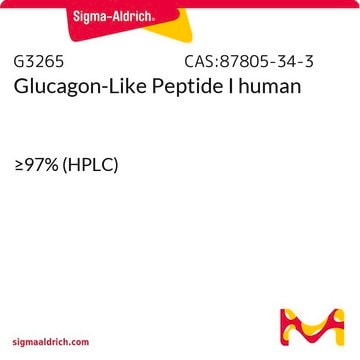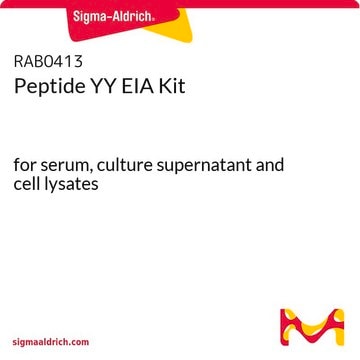おすすめの製品
product name
Multi Species GLP-1 Total ELISA, EZGLP1T-36K, This Multi Species GLP-1 Total ELISA, EZGLP1T-36K, is used to measure & quantify Glucagon Like Peptide-1 levels in Metabolism research.
品質水準
化学種の反応性
human, mouse, rat
包装
kit of 1 × 96 wells
パラメーター
20—50 μL sample volume (4hr assay)
assay range
linearity: 90-132%
recovery range: 90-110%
sensitivity: 1.5 pM
(MinDC)
standard curve range: 4.1-1000 pM
inter-assay cv: <12%
intra-assay cv: <5%
テクニック
ELISA: suitable
入力
sample type cell culture supernatant
sample type plasma (K2 EDTA)
sample type serum
NCBIアクセッション番号
UniProtアクセッション番号
アプリケーション
research use
検出方法
colorimetric (450nm/590nm)
輸送温度
wet ice
保管温度
2-8°C
遺伝子情報
human ... GCG(2641)
詳細
特異性
GLP-1 is conserved in almost all mammals.
アプリケーション
代謝
免責事項
シグナルワード
Danger
危険有害性の分類
Acute Tox. 3 Dermal - Acute Tox. 4 Inhalation - Acute Tox. 4 Oral - Aquatic Chronic 2 - Met. Corr. 1 - Skin Sens. 1
保管分類コード
6.1C - Combustible acute toxic Cat.3 / toxic compounds or compounds which causing chronic effects
適用法令
試験研究用途を考慮した関連法令を主に挙げております。化学物質以外については、一部の情報のみ提供しています。 製品を安全かつ合法的に使用することは、使用者の義務です。最新情報により修正される場合があります。WEBの反映には時間を要することがあるため、適宜SDSをご参照ください。
Jan Code
EZGLP1T-36K:
EZGLP1T-36BK:
試験成績書(COA)
製品のロット番号・バッチ番号を入力して、試験成績書(COA) を検索できます。ロット番号・バッチ番号は、製品ラベルに「Lot」または「Batch」に続いて記載されています。
この製品を見ている人はこちらもチェック
ライフサイエンス、有機合成、材料科学、クロマトグラフィー、分析など、あらゆる分野の研究に経験のあるメンバーがおります。.
製品に関するお問い合わせはこちら(テクニカルサービス)









